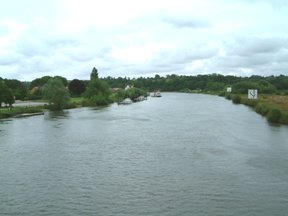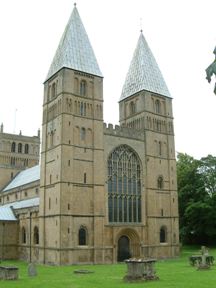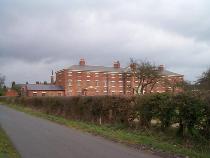Previous Chapter
Friday 20th July 2007
Waltham on the Wolds to Southwell
The weather forecast for today is particularly nasty, with flood warnings for Wales and the West country and heavy rain moving towards the east as the day progresses. For this reason we decide to complete today's ride as soon as possible and aim to spend the afternoon in Southwell hopefully in the dry. The B&B is in the village of Rolleston about 3 miles outside Southwell so perhaps we won't get too wet.
 At least the wind is being kind to us today and we sail along across the Wolds and then down into the Trent valley through the villages of Harby, Langar and Bingham. We cross the Trent at the village of Gunthorpe and here Locks Tea Rooms provide us with a well deserved cuppa. After a short break we are on the bike again following the river through Hoveringham, Bleasby and Fiskerton and eventually reaching Southwell before lunchtime. We sit in the churchyard overlooking the Minster eating our sandwiches.
At least the wind is being kind to us today and we sail along across the Wolds and then down into the Trent valley through the villages of Harby, Langar and Bingham. We cross the Trent at the village of Gunthorpe and here Locks Tea Rooms provide us with a well deserved cuppa. After a short break we are on the bike again following the river through Hoveringham, Bleasby and Fiskerton and eventually reaching Southwell before lunchtime. We sit in the churchyard overlooking the Minster eating our sandwiches.
 The main entrance to the Minster is via the North door and here a very grand entrance provides enough room for us to park the tandem without being in the way of other visitors. We arrive part way through a lunchtime concert - piano, flute and bass guitar - the music is fairly modern and the musicians hardly out of their teens. As soon as we enter we are offered free tea, cake and sandwiches - I can't refuse the cake even though we have just eaten. The concert is soon over and we begin our own tour of the building. Unusually guided tours are not on offer and there is no charge for admission. The present building dates from 1108. Like most cathedrals it has suffered from fires and lightning damage. The pepperpot spires at the West end of the church existed up to 1800 when they were removed because the building was in poor condition. New pepperpots (unique in this country) were added in the late 1800's and the minster eventually became a cathedral in 1884 for the newly formed Diocese of Southwell
The main entrance to the Minster is via the North door and here a very grand entrance provides enough room for us to park the tandem without being in the way of other visitors. We arrive part way through a lunchtime concert - piano, flute and bass guitar - the music is fairly modern and the musicians hardly out of their teens. As soon as we enter we are offered free tea, cake and sandwiches - I can't refuse the cake even though we have just eaten. The concert is soon over and we begin our own tour of the building. Unusually guided tours are not on offer and there is no charge for admission. The present building dates from 1108. Like most cathedrals it has suffered from fires and lightning damage. The pepperpot spires at the West end of the church existed up to 1800 when they were removed because the building was in poor condition. New pepperpots (unique in this country) were added in the late 1800's and the minster eventually became a cathedral in 1884 for the newly formed Diocese of Southwell
By the time we finish it is beginning to rain so we make our way to the refectory for an afternoon cuppa, and then, with capes on, leave the town to visit the Workhouse about a mile away. This property is now owned by the National Trust and provides a good insight into the conditions that people experienced in these establishments during the middle and late 1800's. Nottinghamshire was the first area to implement a system of poor relief that was intended to deter the poor from seeking parish relief. The implementation of the idea was largely the work of the Rev John Becher.  This particular building was a pioneering example of the workhouse system and was used up until the mid 1900's to house the homeless. The workhouse was divided up into five main areas - two for the aged and infirm (male and female separate), two for the so called able (male and female separate) and the last for the children, who were removed from their parents and could only meet them for maybe an hour a week. I wonder what the conditions were like for my great great grandfather Nash Newman who spent his last days in a workhouse in Bath? The Bath workhouse eventually became the Manor Hospital and I understand other workhouses were similarly converted.
This particular building was a pioneering example of the workhouse system and was used up until the mid 1900's to house the homeless. The workhouse was divided up into five main areas - two for the aged and infirm (male and female separate), two for the so called able (male and female separate) and the last for the children, who were removed from their parents and could only meet them for maybe an hour a week. I wonder what the conditions were like for my great great grandfather Nash Newman who spent his last days in a workhouse in Bath? The Bath workhouse eventually became the Manor Hospital and I understand other workhouses were similarly converted.
When we leave the workhouse the rain is torrential. Donning capes - which we had left outside in an attempt to keep the worst of the weather off the bike, but had failed miserably - we pedal and splash our way towards the B&B in Rolleston. The rim brakes are pretty useless in these conditions, but fortunatley the disc brake is still working on the back. 15 minutes later we arrive sodden and dripping outside our destination and are welcomed (maybe slightly reluctantly!) into our lodgings. The owner very kindly offers us the use of the dryer and we are able to leave our wettest belongings to dry in the outhouse. He even offers to take us in the car to the nearest pub for our meal that evening, an offer we very gratefully accept.
Mileage today 33.4 miles Total mileage so far 335.5 miles